Content
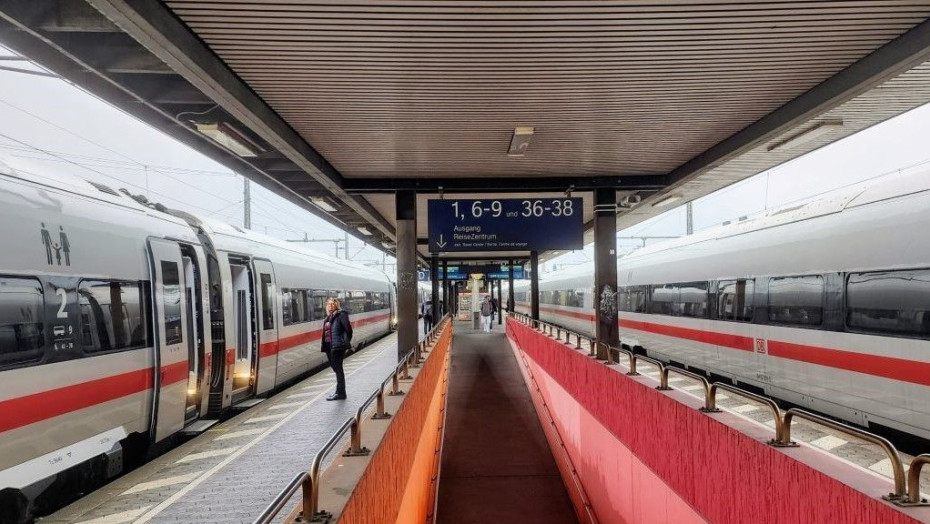
ICE Trains (an overview)
This general guide to ICE trains explains the differences between the six different types of ICE train, the routes they take and what you can expect on board.
Share
At a Glance
Travel Pass Supplement
Rail Pass Reservation Fees
Reservations
Available
Time of Day
Day
Catering
Food services available
Bistro (bar food and take away meals)
Accessibility
Accessing the train
Wheelchair Spaces
Train Specification
Attributes of the train
Has a Conductor
High Speed (partial journey)
Country
Which country these trains operate in.
Germany
Travel Passes
Eurail
Interrail
On Board
1
Perks
WiFi
A complimentary WiFi portal is available throughout this train.
Power Socket
The power sockets on this train are compatible with standard E.U. two point plugs.
At Seat Catering
According to the time of day of travel, passengers will be able to choose from a menu of catering options, which will then be served at their seats.
2
Perks
Power Socket
The power sockets on this train are compatible with standard E.U. two point plugs.
WiFi
A complimentary WiFi portal is available throughout this train.
The ICE train travel guide:
There are now 7 types of ICE train in service, so click on the buttons below if you know which type of train you will be travelling by.
Detailed info on each type of ICE train
Click on the buttons below to access info such as on board facilities, and what to look out for when boarding and travelling with luggage/bikes.
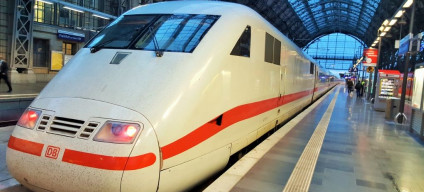
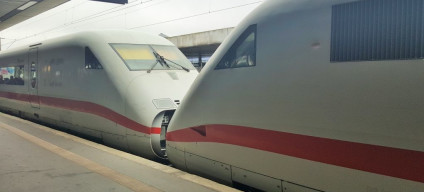
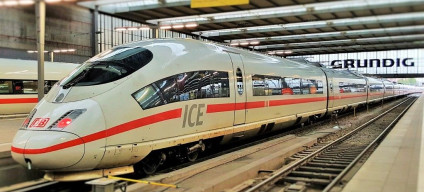
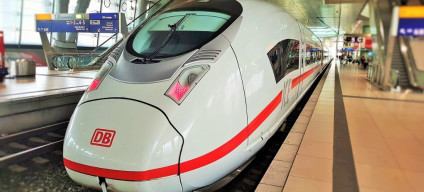
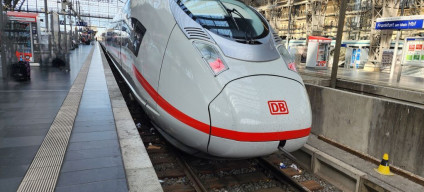
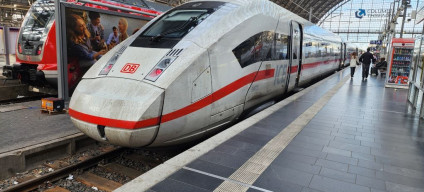
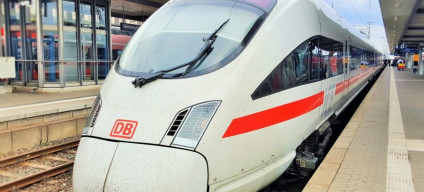
Good to know

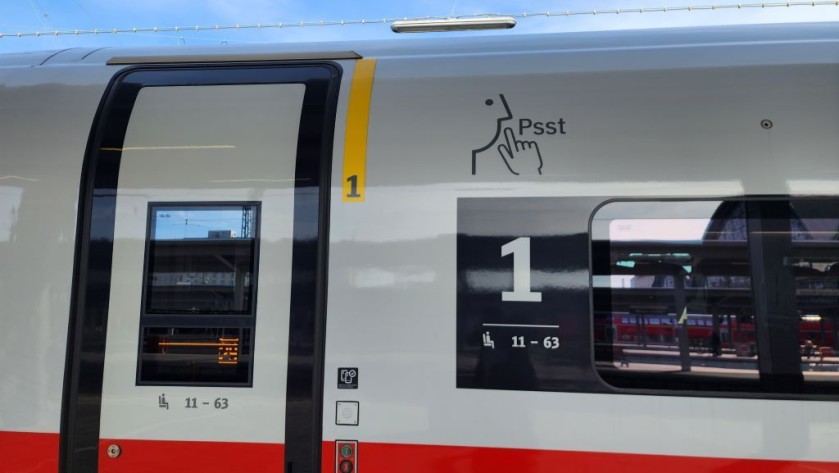
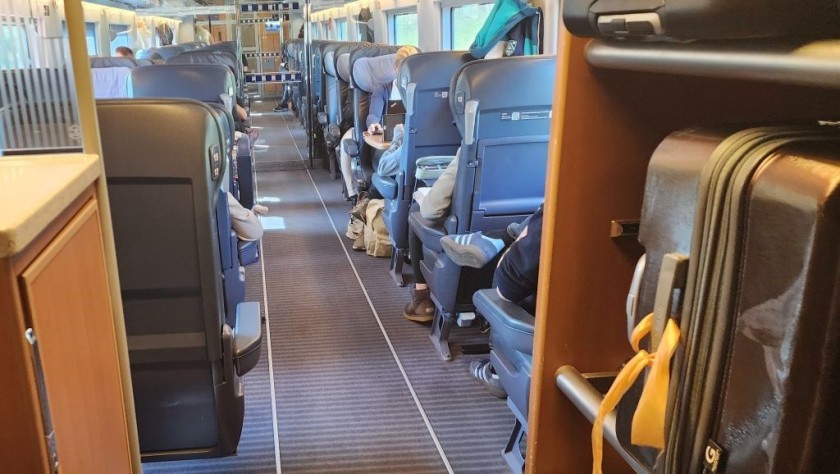
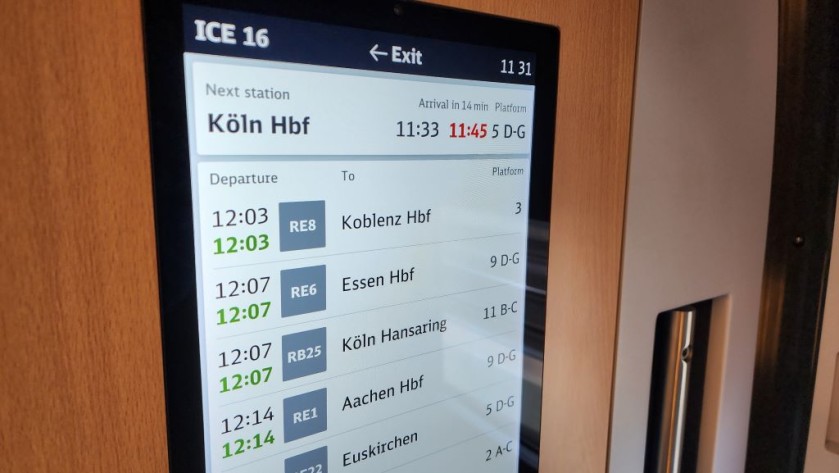
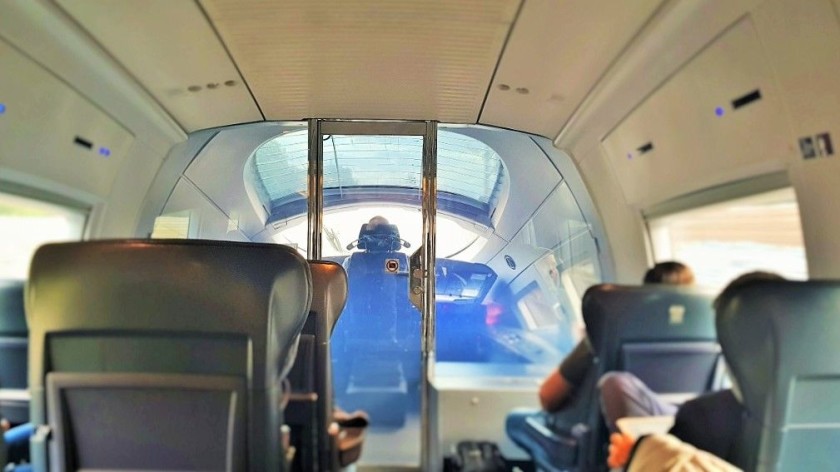
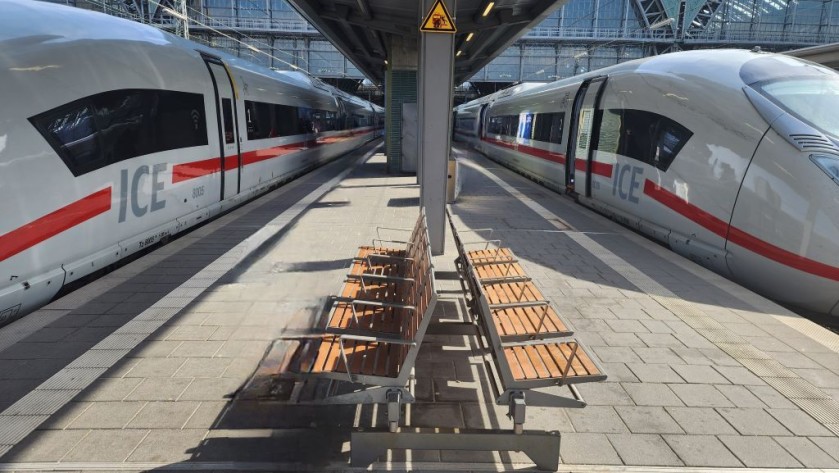
On the journey guides SMTJ strives to make the distinction between specific types of ICE train being used on each route, because the on-board experience varies depending on which type of ICE train you will be used for your journey.
ICE trains are generally fabulous, but being on an ICE1 train can feel very different to travelling on an ICE-T train etc.
Features these trains share:
All ICE trains have:
(1) A bistro bar serving drinks, snacks and hot/cold light meals
(2) A restaurant area for a meal service
(3) An at seat service in 1st class of the bar and restaurant menu (but note that the food/drink is not complimentary)
(4) Family compartments and other family areas within the train.
(5) 'Quiet' and 'Phone' zones within the train.
Travellers are not supposed to use their phones in 'Quiet' coaches/zones, the conductor or your fellow passengers will ask you not to do so.
Mobile phone usage is permitted in the 'Phone zones', but in effect this means any seat on the train, that's NOT located in a Quiet Zone'
If you know that you'll want to use your mobile device during your journey, you can select 'seat in a 'Phone zone' - and conversely you can book a seat in a 'Quiet Zone' if you don't want to be disturbed by mobile phone usage.
If you haven't reserved, you'll be less likely to be aware of these 'zones' when boarding a train and looking for seats.
You may unwittingly find a seat available, which happens to be in a 'mobile' or 'quiet' coach, when either of these zones may not have been your preference.
So look for the symbols on the outside and the inside of the trains
Summary of differences:
The key differences between the different types of ICE trains can be summarised as:
Compartment seats available to all passengers = only the ICE 1 and ICE-T trains and the ICE 3 (original) trains
End of train lounges =only on the ICE 3 original and ICE T trains
Bike racks = only on ICE 4 trains and the ICE 3neo traine; Though spaces for non-folding bicycles are now also available on ICE-T trains
Summary of the type of train used on each route:
This is not a comprehensive list, it's a summary of the type of ICE train USUALLY used on each of these routes - in both directions
Berlin - Kassel - Frankfurt (Main) - Mannheim - Kalrsruhe - Basel - Bern - Interlaken:
all departures by ICE 4 trains
Berlin - Kassel - Frankfurt (Main) (Sud) - Frankfurt Airport / Karlsruhe / Stuttgart:
all departures will by ICE 1 trains (9 car variant)
Berlin - Hannover - Hamm - Dortmund - Essen - Duisburg - Dusseldorf:
all departures by ICE 2 trains
Berlin - Hannover - Hamm - Wuppertal - Koln/Cologne hbf:
all departures by ICE 2 trains
Stralsund - Berlin - Halle - Erfurt - Frankfurt (Main) - Saarbrucken (Sprinter):
all departures will be by ICE 1 trains (9 car variant)
Berlin - Halle - Erfurt - Nurnberg - Munich/Munchen (Sprinter)
all departures will be by ICE 3neo trains
Berlin - Erfurt - Nurnberg - Regensburg - Linz - Wien/Vienna:
all departures by ICE T trains
Berlin - Frankfurt Sud - Karlsruhe - Strasbourg - Paris (Est)
by ICE 3 Velaro trains
Dresden – Leipzig – Erfurt – Frankfurt (Main) - (Weisbaden)
all departures by ICE T trains
Frankfurt Main – Frankfurt Flughafen - Koln Hbf - Aachen – Liege – Bruxelles Nord - Bruxelles Midi/Zuid
all departures by ICE 3neo trains
Frankfurt (Main) – Frankfurt Flughafen - Koln Hbf – Dusseldorf – Duisburg – Arnhem – Utrecht – Amsterdam
all departures by ICE 3neo trains
Frankfurt Main – Frankfurt Flughafen - Limburg Sud - Montabaur - Seigburg/Bonn - Koln Hbf (- Wuppertal - Dortmund)
all departures by ICE 3neo trains
Frankfurt (Main) - Mannheim - Kaiserlautern - Paris (Est)
- some departures by ICE 3 Velaro trains
- (other departures by TGV InOui trains)
Frankfurt (Main) - Mannheim - Karlsruhe - Strasbourg - Paris (Est)
- some departures by ICE 3 Velaro trains
- (other departures by TGV InOui trains)
Hamburg - Berlin - Leipzig - Erfurt - Nurnberg - Munich/Munchen
all departures will be by ICE 4 trains
Hamburg - Berlin - Halle - Erfurt - Nurnberg - Ausburg - Munich/Munchen
all departures will be by ICE 1 trains (9 car variant)
Hamburg - Berlin - Leipzig - Erfurt - Frankfurt (Main) - Mannheim - Stuttgart - Ulm - Augsburg - Munchen:
all departures by ICE 4 trains
Hamburg - Bremen - Dortmund - Koln - Koblenz - Mainz - Mannheim - Stuttgart ( a non-high speed route).
- most departures by ICE 1 trains
- some departures by ICE 4 trains
Hamburg - Hannover - Kassel hbf - Marburg - Frankfurt (Main)
all departures by ICE 4 trains (7 car variant)
Hamburg and Bremen - Hannover - Kassel - Wurzburg – Nurnberg – Munchen/Munich
all departures will be by ICE 4 trains
Hamburg - Hannover - Kassel - Frankfurt (Main) - Frankfurt Flughafen - Mannheim - Stuttgart
all departures by ICE 4 trains
Hamburg - Hannover - Kassel - Frankfurt (Main) - Mannheim - Karlsruhe - Freiburg - Basel
all departures by ICE 4 trains
Hamburg - Bremen - Dortmund - Essen - Dusseldorf - Koln Hbf - Frankfurt Flughafen - Mannheim - Karlsruhe - Freiburg - Basel - destinations in Switzerland
all departures by ICE 4 trains
Hamburg - Bremen - Wuppertal - Koln Hbf - Frankfurt Flughafen - Mannheim - Stuttgart - Ulm - Augsburg - Munchen
all departures by ICE 3 (original) trains
Dortmund - Essen - Dusseldorf - Koln Messe/Deutz - Frankfurt Flughafen - Mannheim - Stuttgart - Ulm - Augsburg - Munchen
all departures by ICE 3 (original) trains
(Dortmund) - Essen - Dusseldorf - Koln Messe/Deutz - Frankfurt Flughafen - Frankfurt (Main) – Frankfurt Flughafen – Wurzburg - Nurnberg – Munchen
all departures will by ICE 3 Velaro trains
Munchen/Munchen - Augsburg - Ulm - Stuttgart - Karlsruhe
all departures by ICE 4 trains (7 car variant)
Stuttgart - Karlsruhe - Strasbourg - Paris (Est)
- some departures by ICE 3 Velaro trains
- (other departures by TGV InOui trains)
Wien/Vienna – Linz – Nurnberg – Frankfurt (Main) – Koblenz – Koln/Cologne
all departures by ICE T trains
Wien/Vienna - Linz - Nurnberg - Erfurt - Berlin
all departures by ICE T trains
This info was sourced on the fantastic train service info resource, Vagonweb.
Tickets & seat reservations:
Reservations are now only automatically included when upgrading 2nd class Flexpreise and Flexpreise Aktion tickets to 1st class, or when booking to travel 1st class with Flexpreise and Flexpreise Aktion tickets.
When purchasing the cheaper Super Sparpreis and Sparpreis tickets for journeys by express train, you can opt to either:
- Travel 2nd class and add a seat reservation for an additional fee of €5.20.
- Book 1st class / upgrade a 2nd class ticket to 1st class and add a seat reservation for an additional fee of €6.50.
When booking Flexpreise and Flexpreise Aktion tickets for travel in 2nd class, you can add a seat reservation for an additional fee of €5.20.
If your journey involves more than one EC, IC or ICE train, you will only have to pay one reservation fee, as it will cover all the trains you will be taking.
It is also possible to book reservations at a later date separately from the ticket booking, both online or by using DB branded ticket machines at stations.
Although if you do book your reservations later and your journey involves more than one train, you will then have to pay for separate reservations per train.
Also worth knowing about seat reservations on ICE trains:
In addition to ensuring that you can remain in one seat for your entire journey, there are 3 less obvious benefits of making a reservation, if you will be travelling 2nd class, or using a 1st class rail pass).
(And when booking 1st class tickets, when reservations are automatically added, these three things are also worth keeping in mind).
(1) You can select between options for the location of your seat, which in addition to window or aisle seats, can include compartment seats and seats at tables.
(2) You can choose in which 'zone' on the train that you wish to travel by - 'Quiet', 'Mobile' or 'Standard'.
(3) You can usually choose specific seats on a seating plan and if you will be travelling on an ICE 1 or ICE 4 train, you will also be able to ensure your seat is facing forwards.
Though if you have opted to face forwards, be aware that ICE trains reverse direction when calling at the hbf stations in Frankfurt (Main), Leipzig and Stuttgart and that also applies to most trains which call at Koln Hbf.
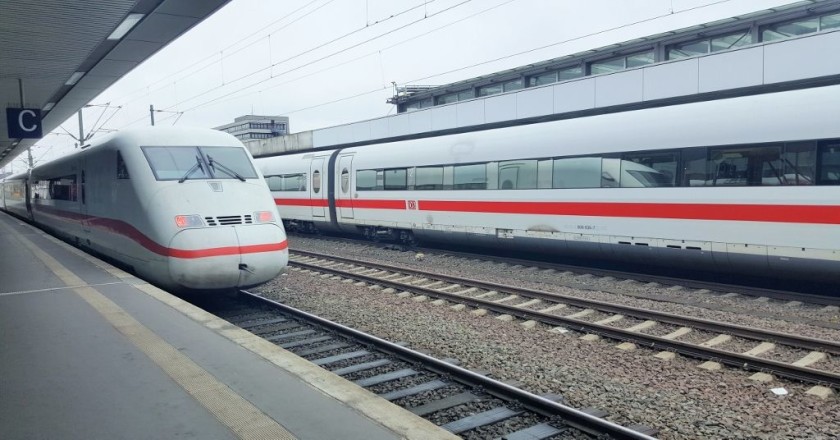
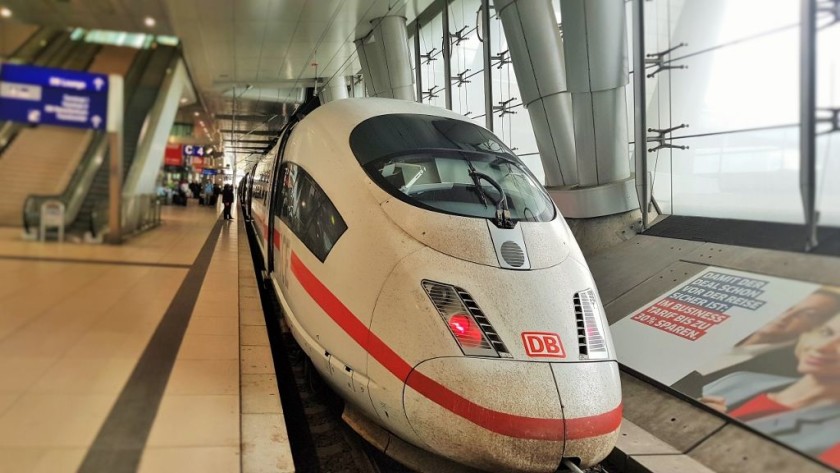
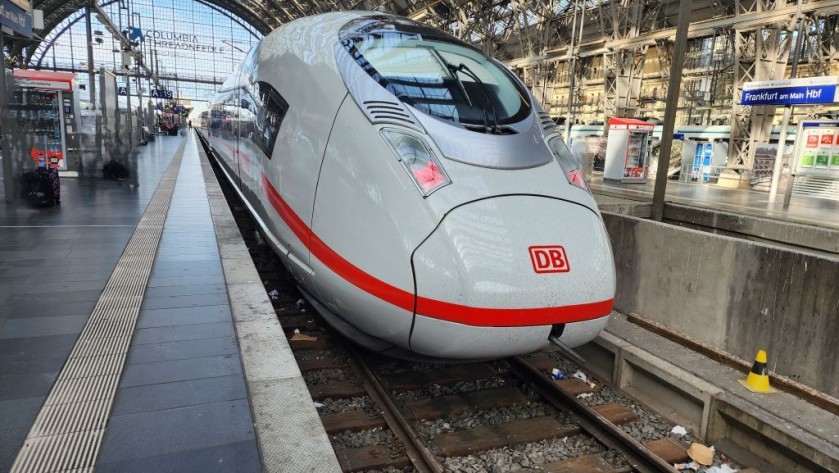
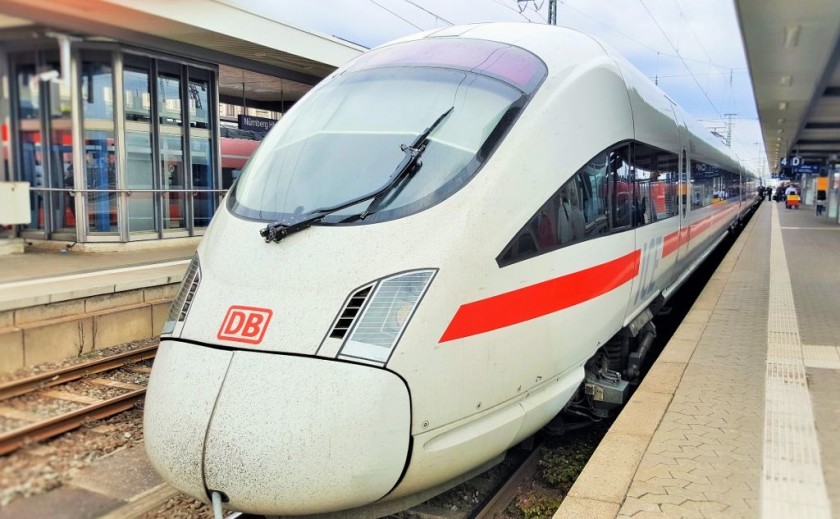
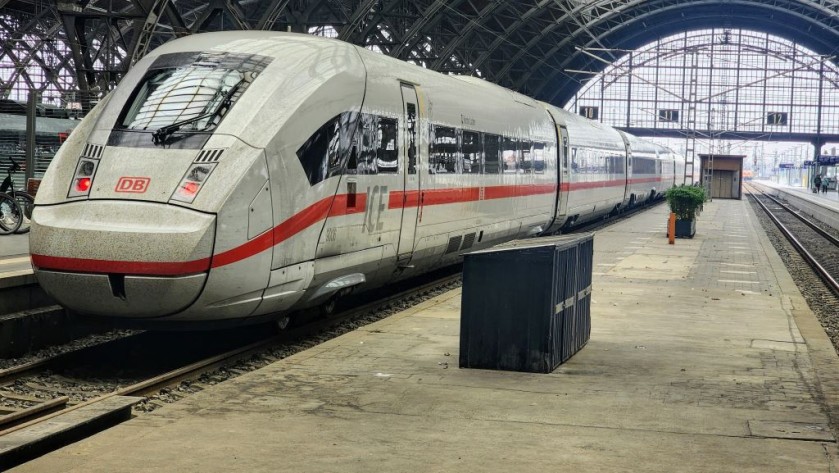
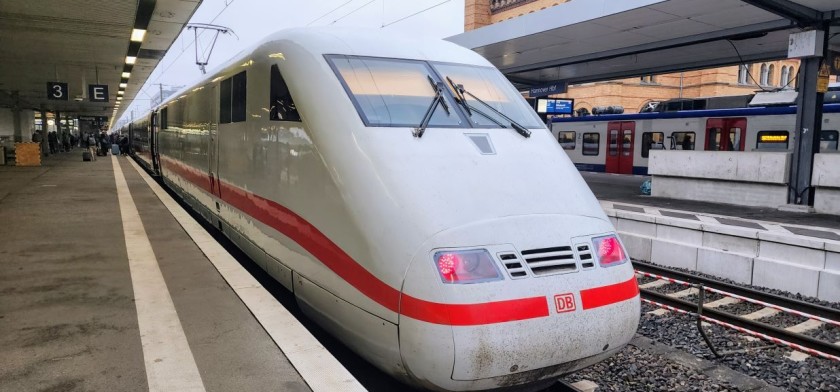
Confirming which type of ICE train is being used on a departure, by using seating plans
When booking tickets for journeys by ICE trains on the DB website, which is managed by the German national rail operator, you can reserve seats by using a seating plan.
These seating plans differ slightly between each type of ICE train, so you can use them to check which type of ICE train is being used for a departure.
Though something to look out for is that the bar / bistro / restaurant cars are only included on these seating plans, if they also house seats which can be reserved.
ICE 1 train (12 coach variant)
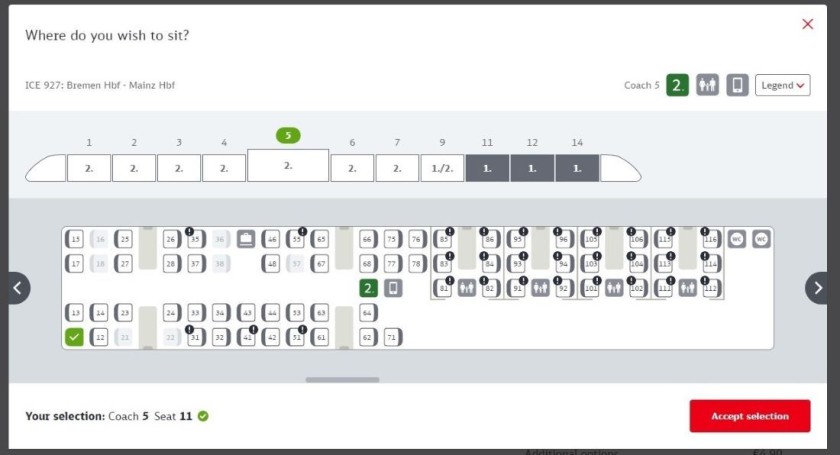
This is a seating plan of the 12 coach variant of an ICE train because coach 9 has both 1st and 2nd class seating - because the 2nd class family compartment is in what is otherwise a 1st class coach.
This split of coach 9 into 1st and 2nd class is unique to this type of ICE train.
ICE 1 train (9 coach variant)
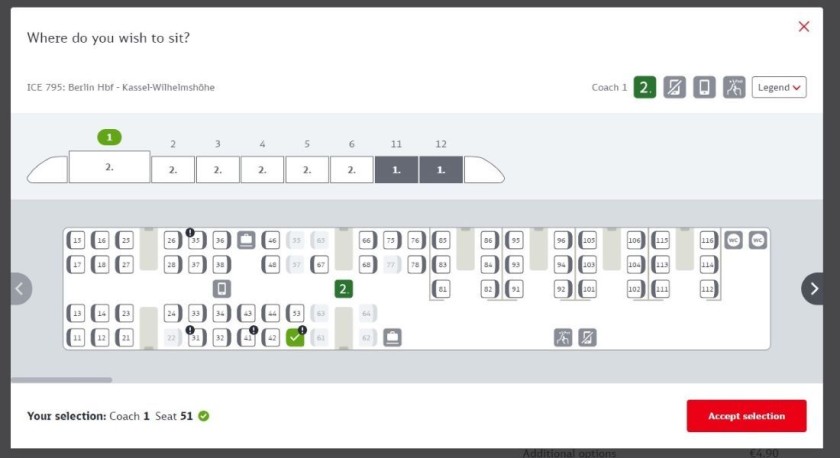
The only version of the ICE trains which have 9 coaches / cars is the 9 coach variant of the ICE 1 trains - which has six x 2nd class cars, two x 1st class cars and 1 x restaurant car
So because the seating plan doesn't show the restaurant car, but the 6 x 2nd class cars and 2 x 1st class cars can be seen, this must be the 9 car variant of an ICE 1 train.
ICE 2 train
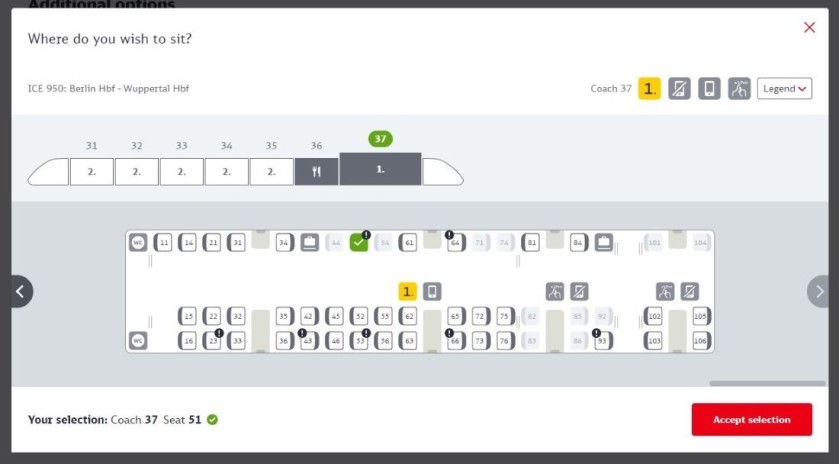
This is a seating plan for an ICE 2 train because coach car 26/36 is the bar / bistro car, but it also has a 1st class seating area, so it shows up on the plan.
Two x ICE 2 trains
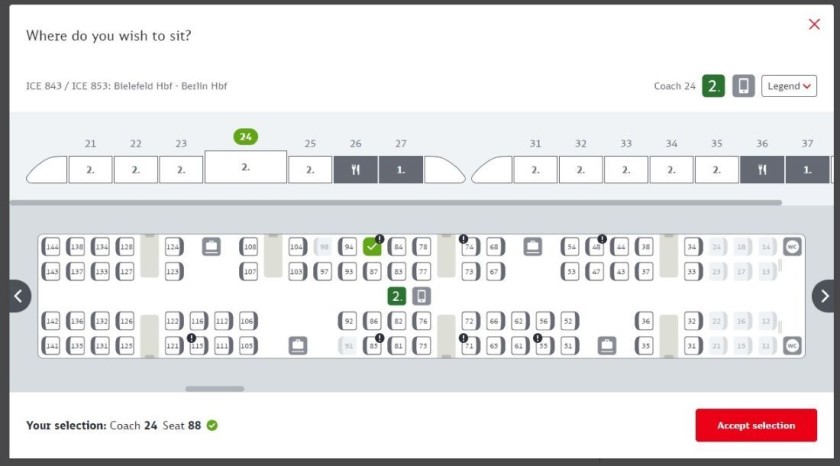
Two ICE 2 trains can be joined together on many sections of their routes.
So when that is the situation, two ICE trains will be shown on the seating plan - with two bar / bistro cars visible, coaches 26 and 36.
ICE 3 train
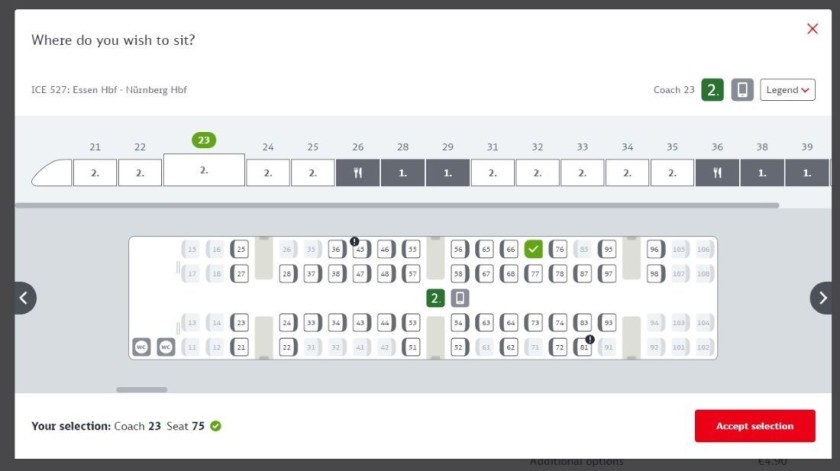
ICE 3 trains uniquely among ICE trains have 8 coaches / cars
5 x 2nd class cars
1 x restaurant car, which also has a 1st class seating are that can be reserved, hence it shows up on the seating plan
2 x 1st class cars.
So blocks of three dark grey 1st class cars, with one of them also being a restaurant car = this must be an ICE 3 train.
Two ICE trains are joined together on most departures by this type of train, hence the double train on the seating plan.
ICE 4 train
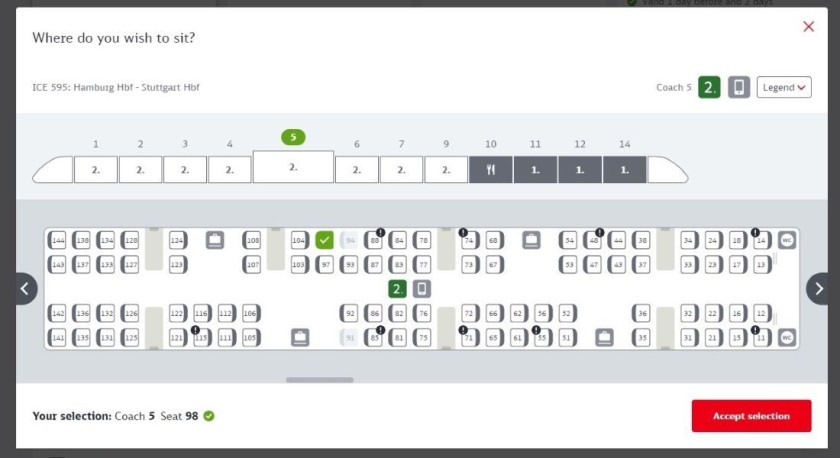
On the 12 / 13 coach variant of the ICE 4 train the restaurant cars have a 1st class seating area which can be reserved, which gives a block of 4 x 1st class cars on the seating plan - shown in the deeper grey.
The 12 / 13 coach variant of the ICE 4 is the only type of ICE train with a block of four 1st class cars.
Some ICE 4 trains have 7 cars.
ICE - T train
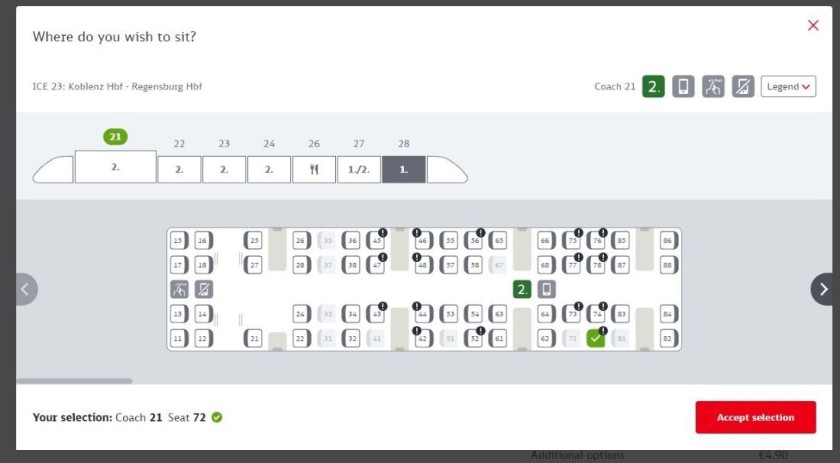
ICE T trains uniquely only have one car / coach which is solely dedicated to 1st class seating, so if you see only 1 x dark grey car on a seating plan, it has to be an ICE-T train - the 7 car or 5 car variant.
This second version of ShowMeTheJourney is exciting and new, so we are genuinely thrilled that you are here and reading this, but we also need your help.
We’re striving not to let anything get in the way of providing the most useful service possible, hence a facility has been set up with DonorBox which can be used to support the running costs and make improvements.
Instead of advertising or paywalls, your financial support will make a positive difference to delivering an enhanced service, as there’s a lot of ideas which we want to make happen.
So if you have found the info provided here to be useful, please consider saying thank you.

This is one of more than 100 train travel guides available on ShowMeTheJourney, which will make it easier to take the train journeys you want or need to make. As always, all images were captured on trips taken by ShowMeTheJourney.



